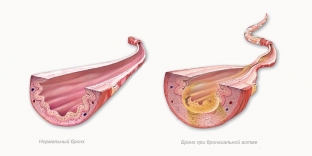The treatment of bronchial asthma can be secretly singled out as a separate large section of modern medicine. It took many years of research to learn how to help such patients. Bronchial asthma is a chronic disease, and this diagnosis accompanies the patient throughout his life. Inhalers become a necessary thing for leaving the house, along with a wallet or apartment keys. Such patients should strictly follow all the recommendations of the attending physician and try to prevent the occurrence of new asthma attacks as much as possible. About what principles should be followed in the selection of a therapeutic regimen for patients with bronchial asthma, says estet-portal.com.
Basic principles and methods of treatment of bronchial asthma
Today, bronchial asthma is not a death sentence for a person. Patients with this pathology live a long wonderful life under the only condition: strict adherence to all the recommendations of the attending physician. Treatment of bronchial asthma implies not only the elimination of the symptoms of pathology during periods of exacerbations of the disease, but also the prevention of these exacerbations, possible complications of the pathology, as well as the transition of the disease to a more severe degree. Convenient small inhalers with drugs can be placed in a pocket or bag, and you can be sure that a new asthma attack will not take you by surprise.
Asthma treatment:
- main goals in the treatment of patients with bronchial asthma;
- asthma management program;
- drug therapy depending on the severity of asthma.
Main goals in the treatment of patients with bronchial asthma
Before recommending any asthma treatment regimen to a patient, the doctor must understand what goals he is pursuing.
The main goals in the treatment of bronchial asthma are as follows:
- Achieving and maintaining maximum control over the symptoms of pathology;
- prevention of asthma complications;
- maintain lung function as close to normal as possible;
- Maintaining a normal level of patient activity;
- elimination of all side effects of anti-asthma drugs;
- prevention of the development of irreversible bronchial obstruction;
- prevention of death in asthma.
Asthma Management Program
The asthma management program is based on the above goals. To achieve them, only the recommendations of a doctor are not enough. The patient must learn to accept his disease and live with it, only this will help make his life as comfortable as possible. The principle of treatment of bronchial asthma consists of six main areas:
- Teaching the patient all the necessary skills for living with asthma.
- Assessing and monitoring asthma severity by constantly recording exacerbations and their symptoms, as well as conducting additional studies.
- Elimination of all possible factors provoking exacerbations.
- Development of individual plans for medical treatment of bronchial asthma.
- Developing individualized treatment plans for periods of exacerbation.
- Ensure regular monitoring of patients with asthma.

Drug therapy depending on the severity of asthma
The development of a drug therapy regimen depends on the severity of asthma:
- in the intermittent form, the treatment of bronchial asthma is prescribed depending on the severity of the manifestations of the symptoms of the disease in each individual patient. Most of them do not require daily use of drugs. At this stage, symptoms can be controlled by inhaled short-acting beta-2 agonists;
- for a mild persistent form, drugs should be taken daily, the use of inhaled glucocorticosteroids is recommended;
- in case of persistent bronchial asthma of moderate severity, it is necessary to regularly take inhaled glucocorticosteroids and long-acting beta-2-agonists. Often patients take drugs 2 times a day;
- in severe persistent bronchial asthma, it is recommended to take large doses of inhaled glucocorticosteroids plus long-acting beta-2-agonists also twice a day.
After achieving control of asthma for 3 months, it is recommended to gradually reduce the amount of therapy to determine the minimum required level.









Add a comment